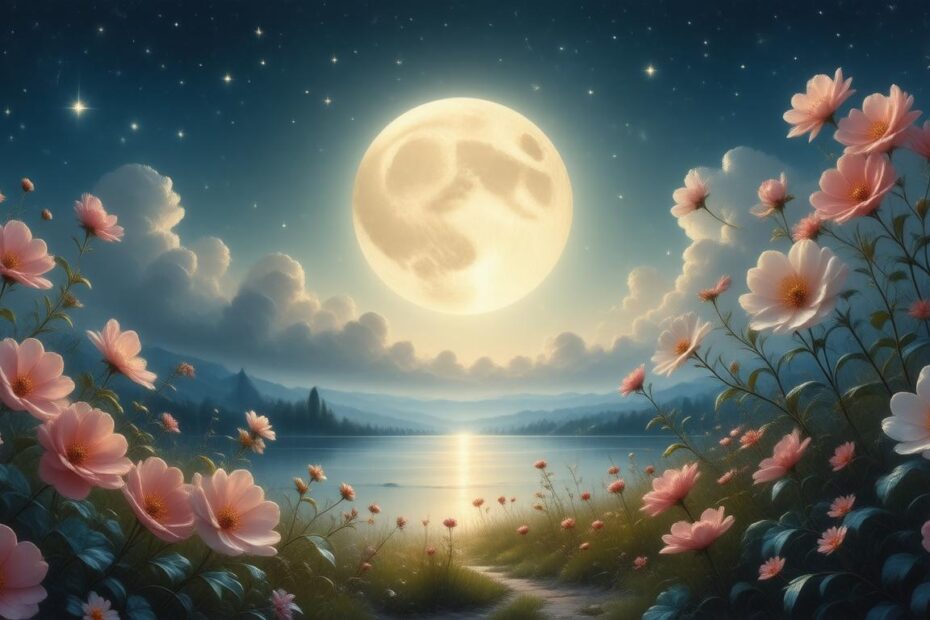🌟 Daily Awakening Quiz 🌟
The Flower Moon, a term steeped in cultural significance and natural beauty, marks the full moon occurring in May—the month when blossoms come into their fullest glory across North America. This captivating celestial event not only enchants sky gazers but also holds deep meanings rooted in history and tradition.
The Origins of the Flower Moon
The name "Flower Moon" is historically linked to the blooming season of flowers in the Northern Hemisphere. Native American tribes, particularly those in the Northeastern U.S. and Canada, were among the first to adopt this term. The Algonquin, for instance, used it alongside other names that depict spring’s awakening. Jonathan Carver, an early American explorer and writer, mentioned it in his 1798 works, echoing the ties between the lunar cycle and natural changes.
Various Native American tribes assigned different names to the May full moon, which reflect the seasonal transitions. For example, the Cree referred to it as the "budding moon" or "leaf budding moon," signaling the new growth emerging in nature. In contrast, the Dakota tribe termed it the "planting moon," representing the agricultural activities as lands were prepared for summer crops. The rich linguistic tapestry surrounding this full moon illustrates how interconnected these communities were with their environment.
Cultural Interpretations
The Flower Moon has also garnered various interpretations in other cultures. The Old Farmer’s Almanac recognizes it among several traditional names, including "Milk Moon"—a term dating back to the medieval period when dairy production peaked. Across different traditions, names like "Dragon Moon" (in Chinese culture) and "Hare Moon" (in Wiccan practices) are similarly inspired by the environmental cues of May.
Astrologically, the Flower Moon is believed to occur in different constellations each year, adding another layer of significance. In 2024, it will align with the constellation Scorpius, suggesting a theme of transformation and deep emotional introspection.
Astrological Significance
Astrologers often use the Flower Moon as an opportunity for reflection and manifestation. Its association with the zodiac sign Scorpio invites a time for vulnerability and introspective exploration. This period is viewed as auspicious for releasing old habits and embracing new beginnings, potentially aligning with personal growth and explorative adventures. Rituals during the Flower Moon can involve activities that signal letting go of the past and welcoming future intentions.
Astrological guidance suggests engaging in practices that harness the full moon’s energy, such as writing down aspirations and burning the paper as a symbolic release, or meditative practices that encourage a mindset open to new experiences.
Modern Interpretations and Observations
The Flower Moon continues to captivate modern audiences, who participate in its festivities across various platforms, celebrating not only its visual splendor but also its cultural and personal significances. Amateur astronomers and enthusiasts gear up to witness this phenomenon, which generally occurs around the May date each year.
The next Flower Moon will brighten the sky on May 23, 2024, promising a spectacular viewing experience as it heralds in the warmth and bounty of summer.
Conclusion
The Flower Moon serves as more than just a celestial event; it symbolizes the vibrant reawakening of life and the possibilities that spring offers. From its historical roots in Native American culture to its modern-day relevance in astrology, the Flower Moon’s rich tapestry of meanings fosters a deeper appreciation for nature and the cosmos. As we gaze upon its luminous beauty, it reminds us of our connection to the natural world, and the cycles of renewal we experience in our own lives. Whether through rituals, reflection, or simply marveling at its glow, the Flower Moon invites us all to celebrate the beauty of life and growth.

